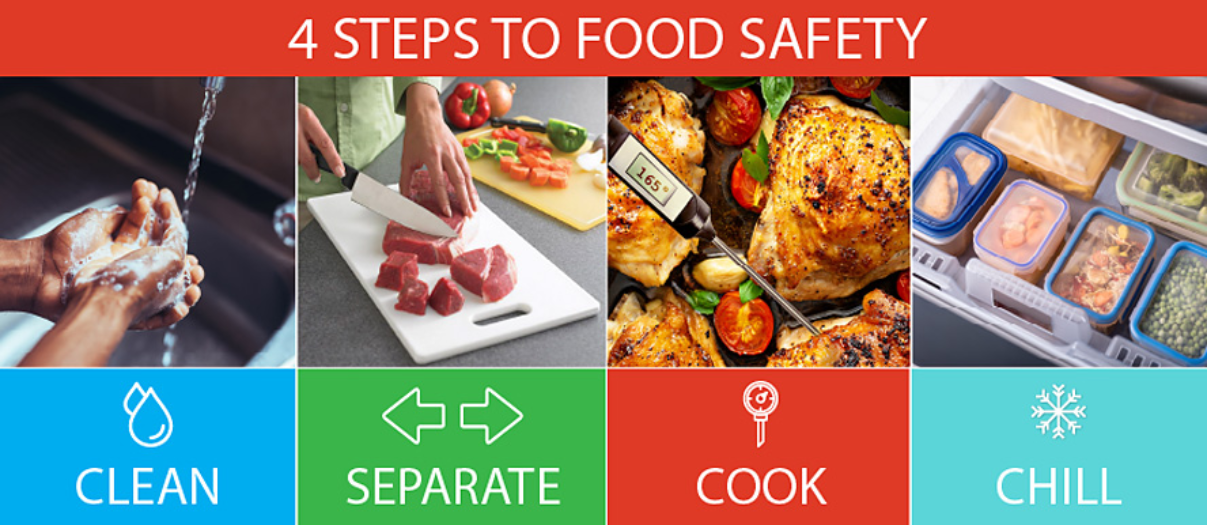
Following four simple steps at home—Clean, Separate, Cook, and Chill(冷藏)—can help protect you and your loved ones from food poisoning(中毒).
Clean: Wash your hands and surfaces often.
◎ Germs that cause food poisoning can survive in many places and spread around your kitchen.
◎Wash your hands for at least 20 seconds with soap and warm or cold water before, during, and after preparing food and before eating. Always wash hands after dealing with uncooked meat, chicken, seafood, or eggs.
◎Wash the cooking tools, cutting boards, and surfaces with soap and hot water after preparing each kind of food.
◎Wash fresh fruits and vegetables under running water.
Separate: Don’t cross-contaminate(交叉污染).
Uncooked meat, seafood, and eggs can spread germs to ready-to-eat food unless you keep them separate.
◎ When you go shopping, keep raw meat, seafood, and their juices away from other foods.
◎Keep meat, seafood, and eggs separate from all other foods in the fridge. Store them in boxes so the juices don’t get into other foods.
◎Use one cutting board for meat and seafood, and a separate cutting board for produce, bread, and other foods that won’t be cooked.
Cook to the right temperature.
Food is safely cooked when the internal temperature gets high enough to kill germs that can make you sick. The only way to tell if food is safely cooked is to use a food thermometer(温度计). You can’t tell if food is safely cooked by checking its color and texture (except for seafood).
Chill: Refrigerate promptly.
Germs grow rapidly if left at room temperature or in the “Danger Zone” between 8℃ and 60℃. Keep your fridge at 8℃ or below and your freezer at 0℃or below, and know when to throw food out before it goes bad. For example, the right temperature for ham is at 8℃ or below, but do not freeze, or it will go bad.
1.What should we do before eating an apple according to the passage?
A Take the skin off the apple.
B Wash the apple with running water.
C Wash the apple for at least 20 seconds.
D Wash the apple with soap and warm water.
解析:选B。B细节理解题。根据第二段最后一点“Wash fresh fruits and vegetables under running water.”可知,新鲜的水果和蔬菜需要在流水下面清洗,即在吃苹果前需要用流水冲洗。故选B。
2.What does the underlined word “raw” probably mean?
A Processed.
B Uncooked.
C Convenient.
D Locally produced.
解析:选B。B词义猜测题。根据第三段第一句“Uncooked meat, seafood, and eggs can spread germs to ready-to-eat food unless you keep them separate.”可知,此处讲的是要把生的(即“未煮过的”)肉、海鲜、鸡蛋与其他食物分开。故选B。
3.Why should we tell if food is safely cooked by its temperature?
A Because high temperature changes the color of food.
B Because only high temperature can kill germs.
C Because low temperature can protect food.
D Because low temperature keeps the texture.
解析:选B。B细节理解题。根据倒数第二段第一句“Food is safely cooked when the internal temperature gets high enough to kill germs that can make you sick.”可知,当食物内部温度足够高时就可以杀死食物里面的致病细菌,所以我们需要通过食物的温度来判断食物是否被安全烹饪。故选B。
4.What can we know from the passage?
A We can use the same cutting board for fish and bread.
B We should wash our cooking tools with cold water.
C It’s safe to put food at room temperature.
D -8℃ is not a safe temperature for ham.
解析:选D。D推理判断题。根据最后一段最后一句“For example, the right temperature for ham is at 8℃ or below, but do not freeze, or it will go bad.”可知,火腿应该冷藏在8摄氏度以下,但是不能冷冻(不能低于0摄氏度)。故选D。
5.The passage above is probably _______.
A a notice
B a news report
C an instruction
D an advertisement
解析:选C。C推理判断题。根据全文内容可知,本文是一篇关于食品安全的指示。故选C。